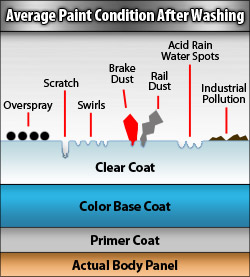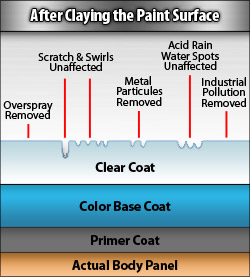What is detailing?
True detailing is an art form that requires a great amount of skill to perform correctly. Its not just simply washing and cleaning, though it does involve these things. Detailing can be defined as the systematic rejuvenation and protection of the various surfaces of a vehicle. Detailing is primarily about proper paint care, paint correction (restoration), and maintaining the paint finish and protecting it. And doing all those things to all the other exterior surfaces. It is about proper interior deep cleaning (restoration), stain removal, and maintaining and protecting the interior surfaces. It is the process that brings a car back to life, restores it's original luster, and protects it for the future. Proper detailing does not take any kind of shortcuts by using the cheapest products available or by covering up problems only for them to become visible later. It does everything perfectly, thus avoiding harming any surfaces and getting ultimate potential results.
How long does a detail take?
This depends greatly on which level of service you choose and the condition of the vehicle.
A signature detail on a car with bad paint blemishes and nasty stains on the interior could take 12 to 24 hours to complete. An express detail on a car that is in relatively good condition would probably take around 3 to 4 hours. The higher the level of service, the more in depth the work gets thus taking a longer time (as well as the fact that the higher levels have more individual services to perform).
How often does my car need to be waxed?
This depends largely on three things: what is the weather the weather like were you live, what is the condition of the paint, and what type and quality of wax is it. harsh rainy weather and chemical pollution eventually wears on the wax as well as UV rays. Old scratched paint with a thin clear coat needs to be waxed relatively frequently as compared to newer paint with a thick clear coat. Synthetic waxes (or paint sealants) generally hold up longer than a natural carnauba wax, (even though synthetics do not offer as much rich gloss as carnauba) but a high quality wax is what matters most, synthetic or natural. Almost all high end waxes contain at least some carnauba. In standard conditions on average paint, a quality carnauba wax can last up to two months. However, in order to maintain maximum shine and luster your paint should be waxed around twice a month. A good rule of thumb to tell wether your car needs a new coat of wax is to see if water beads form and roll off the surface of the paint. If the water does'nt bead, then that is a good indicator that your car needs another application of wax.
Why does my paint feel rough and gritty even after I wax it?
The wax seals the paint, deepens gloss, and provides a coat of protection but it does not clean, polish, or remove surface contaminants.
the reason the paint feels rough is because of bonded micro contaminants that are stuck and embedded in the clear coat. Contaminants include: over spray, brake dust, rail dust, tree sap mist, industrial fallout, acid rain water spots, and bird dropping etchings. Only once these contaminants are removed and the surface is as smooth as glass will you achieve crystal clear reflections.


The contaminants can only be removed using proper teqhnique with a detailing clay and clay lubricant. No amount of polishing or buffing can normally remove them.
How can all the tiny swirls that are all over my paint be removed?

These swirls called spider web scratches or cobweb swirls, can only be removed using a rotary, forced action, or dual action polisher and the proper compound and pad. The clear coat is leveled with the polisher and compound to remove the swirls. The compound is filled with millions of microscopic abrasives to actually cut the clear coat to level it. The grade of abrasiveness of the pad and compound used is determined by how deep the swirls are. They are most commonly Caused because of poor and incorrect washing and polishing/compounding teqhniques. Incorrect teqhniques include using only one bucket to wash with, using inferior grade washing products and using to harsh of a compound or pad. You have to be very careful who you let detail your car as your car could be seriously damaged from sloppiness and incorrect teqhniques.
What is clear coat?
Clear coat is a non pigmented resin paint just like the base coat only its clear. Simply put it's a layer of clear resin put over colored resin. Basically 95% of all cars today have a clear coat finish. Clear coat finish is what really makes the paint have that glassy, glamorous shine. The amount of clear coat on top determines the amount of luster and gloss the paint has. The finish makes the paint look wetter and deeper. Clear coat is there for the main reason of protecting the base coat. All paint has some some small amount of enamel mixed in it to protect from fading and oxidation, this is called single stage paint. The paint that has a clear coat (i.e.enamel on top of the paint) is called two stage paint.
Modern clear coats are often made very hard and with UV inhibitors to protect from oxidation for a longer period of time. They makes it so that blemishes like water spots and swirls can be removed without hurting the paint beneath. Eventually however, the clear coat does become cloudy, dull and oxidized giving the paint a dull faded look, it also can crack and peel off. When this happens it must either be machine compounded or wet/dry sanded. Most oxidation can be prevented by regular washing and using a high quality paint sealant or wax. If it hasn't been done before your car probably needs to be clayed as well to remove bonded contaminants like industrial pollution and tree sap mist that are eating away and destroying your clear coat. Even something like bird droppings and bug splatter on the surface can be very dangerous because of the chemicals that are in them. The natural chemicals in the contaminants react with the chemicals in the clear coat and the result is the clear coat being destroyed.


No comments:
Post a Comment